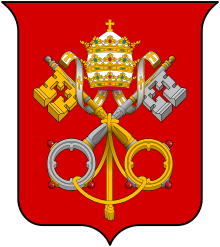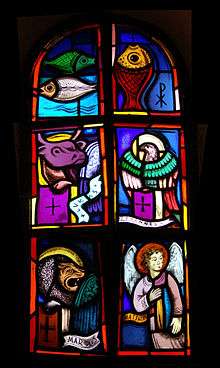Pope Innocent I
| Pope Saint Innocent I | |
|---|---|
 | |
| Papacy began | 22 December 401[1] |
| Papacy ended | 12 March 417 |
| Predecessor | Anastasius I |
| Successor | Zosimus |
| Personal details | |
| Born |
11 March 378 Albano, Italy |
| Died | 12 March 417 |
| Sainthood | |
| Feast day |
|
| Venerated in | Roman Catholic Church |
| Other popes named Innocent | |
Pope Innocent I (Latin: Innocentius I; died 12 March 417) served as the Catholic Church Pope from 401 to his death in 417.[2]
Biography
According to his biographer in the Liber Pontificalis, Innocent was a native of Albano Laziale and the son of a man called Innocentius,[2] but his contemporary Jerome referred to him as the son of the previous pope, Anastasius I, probably a unique case of a son succeeding his father in the papacy.[3] According to Urbano Cerri, Pope Innocent was native of Albania.[4]
Innocent I lost no opportunity in maintaining and extending the authority of the Roman apostolic See, which was seen as the ultimate resort for the settlement of all ecclesiastical disputes. His communications with Victricius of Rouen, Exuperius of Toulouse, Alexander of Antioch and others, as well as his actions on the appeal made to him by John Chrysostom against Theophilus of Alexandria, show that opportunities of this kind were numerous and varied. He took a decided view on the Pelagian controversy, confirming the decisions of the synod of the province of proconsular Africa, held in Carthage in 416, which had been sent to him, and also writing in the same year in a similar sense to the fathers of the Numidian synod of Mileve who had addressed him (Augustine of Hippo among them). In addition he acted as metropolitan over the bishops of Italia Suburbicaria.[2][5]
The historian Zosimus in his Historia Nova suggests that during the sack of Rome in 410 by Alaric I, Innocent I was willing to permit private pagan practices as a temporary measure. However, Zosimus also suggests that this attempt by pagans to restore public worship failed due to lack of public interest, suggesting that Rome had been successfully Christianized in the last century.[2]
Among Innocent I's letters is one to Jerome and another to John II, Bishop of Jerusalem, regarding annoyances to which the former had been subjected by the Pelagians at Bethlehem.
He died on 12 March 417. Accordingly, his feast day is now celebrated on 12 March, though from the thirteenth to the twentieth century he was commemorated on 28 July.[6] His successor was Zosimus.
Role in establishing Bible Canon
It is accepted that the canon of the Bible was closed c. 405 AD by Pope Innocent, when he sent a list of the sacred books to a Gallic bishop, Exsuperius of Toulouse,[7] identical with that of Trent,[8][9][10] except for some uncertainty in the manuscript tradition about whether the letters ascribed to Paul were 14 or only 13, in the latter case possibly implying omission of the Letter to the Hebrews.[7]
Relics
In 846, Pope Sergius II gave approval for the relics of St. Innocent to be moved by Duke Liudolf of Saxony, along with those of his father and predecessor Anastasius, to the crypt of the former collegiate church of Gandersheim, now Gandersheim Abbey, where they rest until this day.[11]
See also
References
- ↑ http://www.britannica.com/EBchecked/topic/288617/Saint-Innocent-I
- 1 2 3 4
 Herbermann, Charles, ed. (1913). "Pope Innocent I". Catholic Encyclopedia. New York: Robert Appleton Company.
Herbermann, Charles, ed. (1913). "Pope Innocent I". Catholic Encyclopedia. New York: Robert Appleton Company. - ↑ http://www.santiebeati.it/dettaglio/64800
- ↑ Cerri, Urbano; Steel, Richard (1715). An account of the state of the Roman-Catholick religion throughout the world. Transl. To which is added, A discourse concerning the state of religion in England. Transl. With a large dedication to the present pope, by sir Richard Steele [really B. Hoadly.]. Oxford University. p. 2.
- ↑ Dunn, Geoffrey (March 2013), "Innocent I's Letter to the Bishops of Apulia" (PDF), Journal of Early Christian Studies, Johns Hopkins University Press, 21 (1): 27–41, doi:10.1353/earl.2013.0000, ISSN 1086-3184
- ↑ Calendarium Romanum (Libreria Editrice Vaticana, 1969), p. 132; Martyrologium Romanum (Libreria Editrice Vaticana, 2001 ISBN 978-88-209-7210-3)
- 1 2 Text and translation of the list
- ↑ Matthew J. Ramage, Dark Passages of the Bible (CUA Press 2013 ISBN 978-0-81322156-4), p. 67
- ↑ Lee Martin McDonald, Formation of the Bible (Hendrickson Publishers 2012 ISBN 978-1-59856838-7), p. 149
- ↑ John L. Mckenzie, The Dictionary of the Bible (Simon and Schuster 1995 ISBN 978-0-68481913-6), p. 119
- ↑ Birgit Heilmann, Aus Heiltum wird Geschichte. Der Gandersheimer Reliquienschatz in nachreformatorischer Zeit. Thomas Labusiak and Hedwig Röckelein, Regensburg, 2009 (Studien zum Frauenstift Gandersheim und seinen Eigenklöstern, vol. 1).
External links
| Wikimedia Commons has media related to Innocentius I. |
-
 Herbermann, Charles, ed. (1913). "Pope Innocent I". Catholic Encyclopedia. New York: Robert Appleton Company.
Herbermann, Charles, ed. (1913). "Pope Innocent I". Catholic Encyclopedia. New York: Robert Appleton Company. - Find-A-Grave
- Opera Omnia by Migne Patrologia Latina
- Fontes Latinae de papis usque ad annum 530 (Papa Felix IV)
- Liber pontificalis
| Titles of the Great Christian Church | ||
|---|---|---|
| Preceded by Anastasius I |
Pope 401–417 |
Succeeded by Zosimus |

